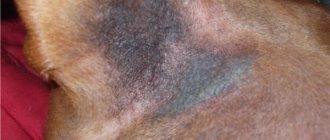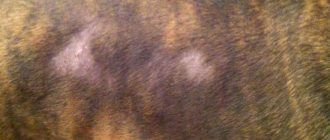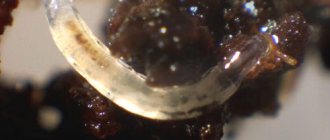What are comedones in dogs?
Canine comedones (blackheads) form at the site of hair follicles to which sweat and sebaceous glands are attached. The gland produces sebum, which is necessary to lubricate the surface of the skin and coat. If it is blocked by dead epidermal cells or dirt, then the fat is sealed inside. This is how comedones are produced.
Acne is divided into 2 main groups:
- superficial – these are found on the surface of the dog’s skin and represent irritation of the hair follicle due to a blockage;
- deep - characterized by the penetration of staphylococcal infection into the skin.
In addition to primary comedones, which do not depend on other diseases, there are secondary ones. They accompany another skin disease. For example, flea dermatitis, demodicosis, allergies.
Important! Regardless of when comedones appear and how many there are, it is important to keep your pet’s skin clean so that the inflamed area does not become infected.
Separately, there are acne skin lesions that are not comedones. But they can be found on the dog's face. Among them:
- juvenile acne - they appear in puppies under the age of 8 months; progress until the puppy is finally transferred to adult food;
- nasal pimples - formed due to injury to the nose; puppies are very curious and stick their noses into everything “interesting”, so they sometimes get injured;
- hyperkeratosis is a thickening of the skin that looks like acne.
If bacteria gets inside a clogged sebaceous duct or hair follicle, an inflammatory process will begin. This disease is called folliculitis. If comedones and inflamed hair follicles are not on the face, but on the back and neck of the dog, then this variant of the disease is called Schnauzer syndrome. Schnauzers and miniature schnauzers are genetically predisposed to it. But the disease can also affect a representative of another breed.
Predisposing factors
The following predisposing factors contribute to the appearance of neoplasms:
- Incorrect, unbalanced diet.
- Poor pet hygiene. Greasy and matted wool is an excellent “reason” for the development of inflammation of the hair follicles.
- Poor living conditions. They contribute to both the deterioration of the coat and the appearance of parasites in the animal’s fur.
- Helminthic infestations. Worms themselves consume a lot of vitamins and nutrients, which causes the animal’s general condition to deteriorate, the immune system weakens, and the risk of developing autoimmune pathologies and other dangerous diseases increases.
Why do they appear?
Comedones are always black in color because fat oxidizes when exposed to oxygen. They are harmless. But they can become a sign of a bacterial infection, ringworm or hormonal diseases in the dog.
Important! Some cases of acne in dogs are caused by trauma to the skin of the chin. As a result, hair follicles become inflamed and acne spreads to other areas of the skin.
In adult animals they occur for the following reasons:
- food allergies from dry dog food;
- poor hygiene;
- bacterial infection;
- fungal infections;
- hormonal pathologies;
- dermatitis due to skin parasites;
- chin injuries.
Factors promoting development
Just like human acne, dog acne does not appear one at a time, but a lot at once. Most owners say that the “pimples” appear suddenly. Indeed, there is no one general reason for the appearance of comedones in a dog. But there are several that are considered the most significant.
Some reasons will vary depending on age. For example, this is quite normal for puppies. Their teenage acne season occurs between 5 and 8 months. In some dogs, comedones appear even at the age of two.
Which dogs are predisposed to the disease?
Another important reason is genetic predisposition. Acne is common in pets with short hair.
But most often they are present in representatives of the following breeds:
- boxers;
- English bulldogs;
- Great Danes;
- German shorthaired pointers;
- Weimaraners;
- mastiffs;
- Rottweilers;
- Doberman pinschers.
Did you know? Allergies aggravate the formation of comedones.
This does not mean that other breeds cannot have comedones. It’s just that in those listed above they are diagnosed much more often.
Clinical picture
Clinical signs are most evident in hyperpigmentation, which is first visible in the axillary and/or groin area. With primary acanthosis, dark spots can be randomly scattered over the damaged area; they do not have an inflammatory background. The primary course is characterized by their gradual development and increase in “blots”. With secondary acanthosis, spots can appear anywhere, but some pronounced focus of appearance is still noticeable. In this case, there is an inflammatory reaction, which has a pronounced tendency to worsen the course.
How do the signs of comedones appear?
Signs of comedones are:
- lumpy skin on the lips and front of the muzzle;
- rash;
- inflammation of the skin;
- swelling;
- ulcers;
- soreness to touch.
If the skin is inflamed and itchy, then the dog will probably get an infection with its claws while trying to scratch the itchy area. In areas of infection, inflammation increases and suppuration may begin. Owners also notice how the pet rubs its muzzle against walls, furniture and people more than usual.
Means for ridding dogs of fleas and their use
Treating a dog for fleas involves treating its fur with special products. It can be:
When choosing what to treat your dog for fleas, you need to take into account the individual characteristics of the animal. Ideally, dogs should be treated for fleas and ticks with products recommended by a veterinarian.
Carrying out diagnostics
Diagnosing comedones is very simple. They are located on the muzzle around the lips and nose. This makes them different from other types of acne.
But to be on the safe side, the veterinarian will use some of the following diagnostic methods:
- skin scraping to examine cells under a microscope for infection or parasites;
- examination of hairs for the presence of mites or fungal infections;
- biopsy - analysis of part of the skin under a microscope;
- blood test to detect autoimmune diseases.
Diagnostics allows us to exclude other skin diseases. Such as dermatitis, allergies, parasites or ringworm.
Did you know? At a young and mature age, the causes of comedones are different. For puppies, body growth is more important. And for older dogs
—
These are sunburns of the skin and various injuries.
Diagnostic techniques
Everything is quite simple here. Since the symptoms are quite obvious, everything is usually limited to a simple external examination. The owner plays a significant role in this “action”. You must tell the specialist about the dog’s feeding conditions, changes or lack of appetite, diarrhea, vomiting, etc. If you have tried to treat your pet with something, do not be shy - if you tell the veterinarian about it in time, there will be much fewer problems later.
As a rule, specialists take a sample of pathological material in the form of a scraping and/or aspirate (pumping out the contents of the acne with a syringe)
. All this is used for further microscopic examination, or is sown on nutrient media for the purpose of growing a culture of the pathogen.
Treatment of comedones in dogs
Comedones are best cleaned with benzoyl peroxide shampoo. It cleanses the surface of the skin, removing dead epidermal cells and sebum. Cleansed pores begin to “breathe”, providing the skin with oxygen. Therefore, shampoo with benzoyl peroxide in its composition can have an antiseptic, antipruritic and deodorizing effect.
The drug will cleanse the dog's skin at the point of use and will not affect other systems and organs, such as an antibiotic. The most common product in this category is the “Doctor Cleansing (for dogs)” pet hygiene shampoo. Manufacturer: Goodman. Price — 241 rub.
The activity of benzoyl is aimed at destroying the bacteria Propionibacterium acnes, which causes acne. It stimulates the removal of old cells. As a result, nothing prevents the proper release of sebum to the surface. With its long-term use, the number of rashes decreases and the appearance of new ones is prevented.
Hydrogen peroxide can also be used. But over time, it can dry out your dog's skin. This is not beneficial, so use peroxide for treatment with great caution.
To loosen and dissolve comedones, your veterinarian will sometimes recommend other local treatments, such as:
- medicated antiseborrheic shampoo;
- ointment.
Important! Like all substances that can exfoliate dead cells, benzoyl peroxide increases skin sensitivity to ultraviolet radiation. Therefore, after using this shampoo, you should not walk your dog on a hot July afternoon.
Drugs used
If treatment with benzoyl peroxide-based shampoo is not enough or comedones are a secondary disease that develops against the background of allergies, dermatitis and other skin problems, then medications may be needed for treatment. Among them:
| Group of drugs | Medicines | Features of application |
| Corticosteroids to relieve skin inflammation and reduce swelling | “Prednisolone” in a dosage of 0.5–1 mg/kg divided into 2 doses per day. | Do not use for longer than 1-2 weeks. |
| Retinoids to normalize the functioning of the sebaceous glands, relieve inflammation and neutralize bacterial microflora | “Isoretinoin” 1 mg/kg every 12 hours for a month; if improvement occurs, then the dose begins to be reduced to 1 mg/kg every other day. For schnauzers 1 mg/kg once a day, for Vizsla dogs - 1–2 mg/kg once a day. | Use only if cleansing the skin with benzoyl peroxide shampoo is ineffective. |
| Antifungal, if the fungal nature of the disease is suspected | “Itraconazole” at a dosage of 5 mg/kg; "Terbinafine" - 30 mg/kg 1 time per day. | Please wait for test results from your veterinarian before using. |
| For hair restoration | Melatonin 1 mg 3 times a day. | Use if the coat begins to thin on the inflamed area. |
| Antibacterial and anti-inflammatory ointments | "Sandoderm", "Unisan" | ?? |
If the skin is inflamed, you will need treatment with antibacterial drugs. The doctor will decide which antibiotic is needed based on the results of the analysis. For treatment to be effective, be sure to take your pet to the veterinarian. All bacteria require precise treatment, otherwise the remedy will not work and complications are possible.
How to care for your dog during recovery
It would also be a good idea to follow a number of hygiene rules:
- When there is acne, bathe your dog 2 times a week.
- Brush her teeth. Oral hygiene is very important for an animal. This way you reduce the chance of bacteria infecting the skin around your lips.
- If there are scratches and scratches, use medicated wound-healing and antibacterial shampoos.
- Use apple cider vinegar diluted with water to wipe the skin. This mixture disinfects the skin and helps fight acne.
Did you know? The simplest folk recipe for skin cleansing
-
using baking soda.
It is diluted with apple cider vinegar to a paste-like consistency and gently cleanses the skin. What you definitely shouldn’t do is squeeze out the contents. When you crush a comedone, the exudate from it will fall on the skin, causing further irritation. If your pet has a bowl with uneven edges, then he can injure his chin while eating and increase inflammation. Therefore, it is necessary to take care of the right dishes for your dog.
Also pay attention to your dog's diet. Many Schnauzer owners note that comedones are less likely to form on their pet’s skin if a raw food diet is used instead of dry food. This diet consists of meat (15%), organ meats (10–30%), whole or ground bones (15%) and sometimes raw eggs, fruits and vegetables.
Some owners add Omega-3 fatty acids and probiotics to the menu. Acids help normalize the functioning of the sebaceous glands. And probiotics improve the digestibility of food and help remove toxins from the body
Further development of the disease
If you don't take your dog to the vet, things will get much worse:
- Small ulcers and boils burst, the chin area is sometimes completely covered with drying pus and ichor.
- As the animal’s immunity weakens, increasingly larger papules and boils appear.
- Bursted boils and papules do not heal; large ulcers develop in their place.
- Due to pain and intoxication, the animal partially or completely loses its appetite.
What are the dangers of comedones?
Since the hair opening is located on the surface of the epidermis, coccoid bacteria can enter it. This often causes an inflammatory process inside the comedon.
Complications include:
- Comedonal rupture. When its contents come into contact with the skin, it causes irritation. The pet scratches an itchy area and introduces an infection into it. In addition to inflammation, this leads to hair loss (alopecia) and the pet looks like “moth-eaten.”
- If the inflamed area is located in the interdigital space, lameness will result. And the dog begins to experience pain when walking.
Find out the causes and treatment of skin spots in dogs.
Prevention
To avoid infection by harmful insects, it is worth taking preventive measures. The main thing is to complete them on time. Then your four-legged friend will be safe. It is important to provide your pet with favorable conditions. Keep the place clean. Wash the bedding regularly and treat the area where it is kept using special preparations. It is important to be systematic and accurate. During your walk, avoid contact with yard animals.
Among the variety of different types of fleas, the dog flea is one of the most common. However, fleas on dogs are not only insects belonging to the actual canine flea species, Ctenocephalides canis.
Pathogen and routes of infection
The causative agent of athlete's foot is the parasitic fungus Epidermophyton floccosum. In the acute phase, the disease is contagious and is transmitted in the following ways:
- autoinoculation - transfer of the fungus from the source of inflammation on the arms or legs;
- indirect route - infection through household items on which there are scales of the epidermis with a pathogenic fungus: clothing, towel, sheet, seat;
- direct – transmission from a carrier during sexual intercourse.
Risk factors contribute to the active development of epidermophytosis of the inguinal folds:
- high humidity and local hyperthermia - the peak incidence is observed in residents of tropical and subtropical climates in the summer;
- tight, dense clothing that does not allow air to pass through - synthetic materials with thick thread;
- increased sweating;
- obesity, diabetes mellitus, immunodeficiency states;
- gonorrhea;
- chlamydia;
- mycoplasmosis;
- trichomoniasis.
In men, such damage to skin folds occurs 3 times more often than in women, according to incidence statistics in the United States.











